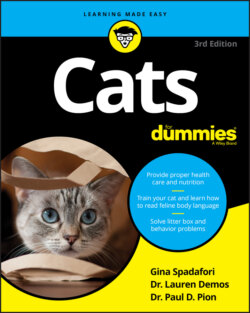Читать книгу Cats For Dummies - Gina Spadafori - Страница 31
A touch of the wild
ОглавлениеOne of the many things we humans find appealing about cats is that, even in the most tame and loving of our household companions, a touch of the tiger remains. Indeed, the tiger’s stripes remain on many of our pets, reminding us always of the connection — a reminder strengthened whenever you watch a cat walk, run, or leap. The grace and power are the same for big cats and for small.
Our cats may have chosen domestication, but on their own terms. And always, always, with a little bit of wildness held in reserve.
That we love this essential wildness is apparent in our long-standing interest in cat breeds that retain the look of the wild about them — not with the “ordinary” tiger stripes of the tabby but with spotted coat patterns evocative of another great wild cat, the leopard.
Most cats with a spotted “wild look” haven’t any wild blood in them at all — they’re the results of breeders trying to develop coat patterns that resemble the domestic cat’s wild cousins (see Figure 2-3). You can put into this category the Ocicat, derived from breedings of the Siamese and Abyssinian and named for the Ocelot, which it resembles. The Egyptian Mau (Mau means cat in Egyptian) is another spotted wonder, a lovely cat bred to resemble the cats seen in ancient Egyptian artwork.
© John Wiley & Sons, Inc.
FIGURE 2-3: The Bengal, Egyptian Mau, and Ocicat evoke the beauty of the Leopard with their spotted coats.
A cat of a different variety altogether is the Bengal, a cat developed through breedings of domestic cats with wild Asian Leopard Cats. Fanciers say the wild temperament has been removed by generations of breeding only the most sociable and friendly Bengals, although the look of the wild cat it came from remains. The Toyger is a litter easier to live with for many people without the cross to wild cats. They’re smaller than Bengals but maintain the wild look without the wild breeding.
The Bengal and other breeds that have been crossed with undomesticated feline species come with responsibilities that many people aren’t prepared for. They can be quite wild and difficult to handle, so much so that Dr. Lauren notes that many veterinarians would strongly recommend that people generally think twice before adopting one of these breeds.
The temperament of these “wilder” breeds generally lies somewhere in the middle between the go-gos and the more easygoing breeds, which we discuss next. They’re not placid layabouts, but neither are they as active as some breeds. For those who love the look of a leopard in a manageable, loving package, these cats are perfect.
